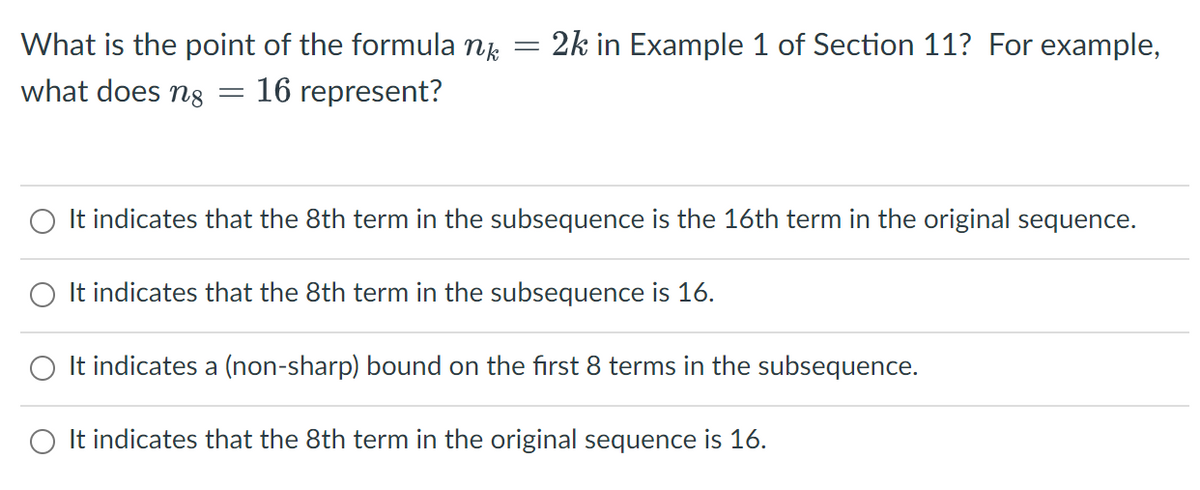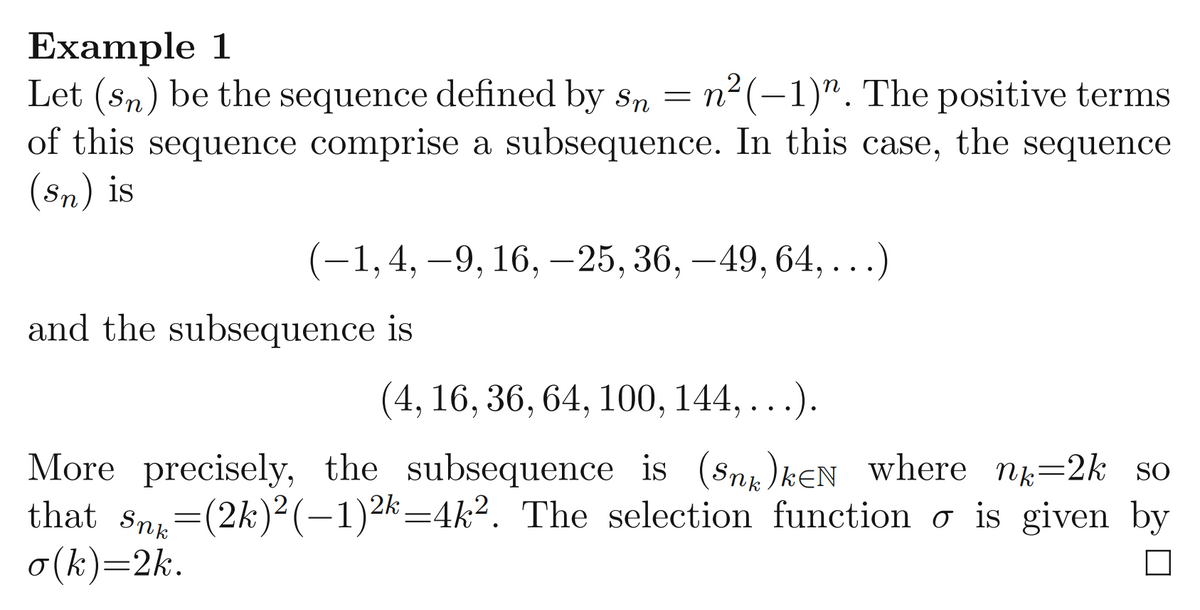What is the point of the formula n. 2k in Example 1 of Section 11? For example, what does ng 16 represent? It indicates that the 8th term in the subsequence is the 16th term in the original sequence. O It indicates that the 8th term in the subsequence is 16. It indicates a (non-sharp) bound on the first 8 terms in the subsequence. O It indicates that the 8th term in the original sequence is 16.
What is the point of the formula n. 2k in Example 1 of Section 11? For example, what does ng 16 represent? It indicates that the 8th term in the subsequence is the 16th term in the original sequence. O It indicates that the 8th term in the subsequence is 16. It indicates a (non-sharp) bound on the first 8 terms in the subsequence. O It indicates that the 8th term in the original sequence is 16.
Algebra for College Students
10th Edition
ISBN:9781285195780
Author:Jerome E. Kaufmann, Karen L. Schwitters
Publisher:Jerome E. Kaufmann, Karen L. Schwitters
Chapter14: Sequences And Mathematical Induction
Section14.1: Arithmetic Sequences
Problem 79PS
Related questions
Question

Transcribed Image Text:What is the point of the formula nk
2k in Example 1 of Section 11? For example,
what does n8
16 represent?
O It indicates that the 8th term in the subsequence is the 16th term in the original sequence.
It indicates that the 8th term in the subsequence is 16.
O It indicates a (non-sharp) bound on the first 8 terms in the subsequence.
O It indicates that the 8th term in the original sequence is 16.

Transcribed Image Text:Example 1
Let (sn) be the sequence defined by sn = n²(-1)". The positive terms
of this sequence comprise a subsequence. In this case, the sequence
(Sn) is
(-1, 4, -9, 16, -25, 36, -49, 64, . . .)
and the subsequence is
(4, 16, 36, 64, 100, 144,
More precisely, the subsequence is (Sn)kEN where n=2k so
that sn=(2k)² (–1)2k=4k². The selection function o is given by
o(k)=2k.
Expert Solution
This question has been solved!
Explore an expertly crafted, step-by-step solution for a thorough understanding of key concepts.
Step by step
Solved in 3 steps with 3 images

Recommended textbooks for you

Algebra for College Students
Algebra
ISBN:
9781285195780
Author:
Jerome E. Kaufmann, Karen L. Schwitters
Publisher:
Cengage Learning

Algebra & Trigonometry with Analytic Geometry
Algebra
ISBN:
9781133382119
Author:
Swokowski
Publisher:
Cengage

Big Ideas Math A Bridge To Success Algebra 1: Stu…
Algebra
ISBN:
9781680331141
Author:
HOUGHTON MIFFLIN HARCOURT
Publisher:
Houghton Mifflin Harcourt

Algebra for College Students
Algebra
ISBN:
9781285195780
Author:
Jerome E. Kaufmann, Karen L. Schwitters
Publisher:
Cengage Learning

Algebra & Trigonometry with Analytic Geometry
Algebra
ISBN:
9781133382119
Author:
Swokowski
Publisher:
Cengage

Big Ideas Math A Bridge To Success Algebra 1: Stu…
Algebra
ISBN:
9781680331141
Author:
HOUGHTON MIFFLIN HARCOURT
Publisher:
Houghton Mifflin Harcourt


College Algebra (MindTap Course List)
Algebra
ISBN:
9781305652231
Author:
R. David Gustafson, Jeff Hughes
Publisher:
Cengage Learning

Algebra and Trigonometry (MindTap Course List)
Algebra
ISBN:
9781305071742
Author:
James Stewart, Lothar Redlin, Saleem Watson
Publisher:
Cengage Learning